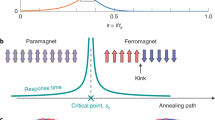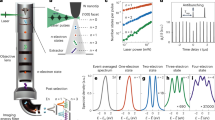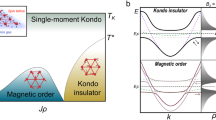Abstract
In solids, the high density of charged particles makes many-body interactions a pervasive principle governing optics and electronics1,2,3,4,5,6,7,8,9,10,11,12. However, Walter Kohn found in 1961 that the cyclotron resonance of Landau-quantized electrons is independent of the seemingly inescapable Coulomb interaction between electrons2. Although this surprising theorem has been exploited in sophisticated quantum phenomena13,14,15, such as ultrastrong light–matter coupling16, superradiance17 and coherent control18, the complete absence of nonlinearities excludes many intriguing possibilities, such as quantum-logic protocols19. Here, we use intense terahertz pulses to drive the cyclotron response of a two-dimensional electron gas beyond the protective limits of Kohn’s theorem. Anharmonic Landau ladder climbing and distinct terahertz four- and six-wave mixing signatures occur, which our theory links to dynamic Coulomb effects between electrons and the positively charged ion background. This new context for Kohn’s theorem unveils previously inaccessible internal degrees of freedom of Landau electrons, opening up new realms of ultrafast quantum control for electrons.
This is a preview of subscription content, access via your institution
Access options
Subscribe to this journal
Receive 12 print issues and online access
$259.00 per year
only $21.58 per issue
Buy this article
- Purchase on SpringerLink
- Instant access to full article PDF
Prices may be subject to local taxes which are calculated during checkout




Similar content being viewed by others
References
Landau, L. Theory of Fermi-liquids. Sov. Phys. JETP 3, 920–925 (1957).
Kohn, W. Cyclotron resonance and de Haas–van Alphen oscillations of an interacting electron gas. Phys. Rev. 123, 1242–1244 (1961).
Kira, M. & Koch, S. W. Semiconductor Quantum Optics (Cambridge Univ. Press, 2011).
Huber, R. et al. How many-particle interactions develop after ultrafast excitation of an electron–hole plasma. Nature 414, 286–289 (2001).
Chemla, D. S. & Shah, J. Many-body and correlation effects in semiconductors. Nature 411, 549–557 (2001).
Kaindl, R. A., Carnahan, M. A., Haegele, D., Lovenich, R. & Chemla, D. S. Ultrafast terahertz probes of transient conducting and insulating phases in an electron-hole gas. Nature 423, 734–738 (2003).
Gaal, P. et al. Internal motions of a quasiparticle governing its ultrafast nonlinear response. Nature 450, 1210–1213 (2007).
Leinß, S. et al. Terahertz coherent control of optically dark paraexcitons in Cu2O. Phys. Rev. Lett. 101, 246401 (2008).
Turner, D. B. & Nelson, K. A. Coherent measurements of high-order electronic correlations in quantum wells. Nature 466, 1089–1092 (2010).
Rice, W. et al. Observation of forbidden exciton transitions mediated by Coulomb interactions in photoexcited semiconductor quantum wells. Phys. Rev. Lett. 110, 137404 (2013).
Almand-Hunter, A. et al. Quantum droplets of electrons and holes. Nature 506, 471–475 (2014).
Matsunaga, R. et al. Light-induced collective pseudospin precession resonating with Higgs mode in a superconductor. Science 345, 1145–1149 (2014).
Noe, G. T. II et al. Giant superfluorescent bursts from a semiconductor magneto-plasma. Nature Phys. 8, 219–224 (2012).
Wang, X., Belyanin, A. A., Crooker, S. A., Mittleman, D. M. & Kono, J. Interference-induced terahertz transparency in a semiconductor magneto-plasma. Nature Phys. 6, 126–130 (2010).
Kukushkin, I. V., Smet, J. H., von Klitzing, K. & Wegscheider, W. Cyclotron resonance of composite fermions. Nature 415, 409–412 (2002).
Scalari, G. et al. Ultrastrong coupling of the cyclotron transition of a 2D electron gas to a THz metamaterial. Science 335, 1323–1326 (2012).
Zhang, Q. et al. Superradiant decay of cyclotron resonance of two-dimensional electron gases. Phys. Rev. Lett. 113, 047601 (2014).
Arikawa, T. et al. Quantum control of a Landau-quantized two-dimensional electron gas in a GaAs quantum well using coherent terahertz pulses. Phys. Rev. B 84, 241307(R) (2011).
Ladd, T. D. et al. Quantum computers. Nature 464, 45–53 (2010).
Wieman, C. E., Pritchard, D. E. & Wineland, D. J. Atom cooling, trapping, and quantum manipulation. Rev. Mod. Phys. 71, S253 (1999).
Press, D., Ladd, T. D., Zhang, B. & Yamamoto, Y. Complete quantum control of a single quantum dot spin using ultrafast optical pulses. Nature 456, 218–221 (2008).
Kampfrath, T. et al. Coherent terahertz control of antiferromagnetic spin waves. Nature Photon. 5, 31–34 (2011).
Kampfrath, T., Tanaka, K. & Nelson, K. A. Resonant and nonresonant control over matter and light by intense terahertz transients. Nature Photon. 7, 680–690 (2013).
Hu, C. M., Batke, E., Köhler, K. & Ganser, P. Interaction coupled cyclotron transitions of two-dimensional electron systems in GaAs at high temperatures. Phys. Rev. Lett. 75, 918–921 (1995).
Hu, C. M., Batke, E., Köhler, K. & Ganser, P. Resonant polaron coupling of high index electron Landau levels in GaAs heterostructures. Phys. Rev. Lett. 76, 1904–1907 (1996).
Mittendorf, M. et al. Carrier dynamics in Landau-quantized graphene featuring strong Auger scattering. Nature Phys. 11, 75–81 (2015).
Al-Jibbouri, H. & Pelster, A. Breakdown of the Kohn theorem near a Feshbach resonance in a magnetic trap. Phys. Rev. A 88, 033621 (2013).
Ghosal, A., Güclü, A. D., Umrigar, C. J., Ullmo, D. & Baranger, H. U. Correlation-induced inhomogeneity in circular quantum dots. Nature. Phys. 2, 336–340 (2006).
Kira, M. & Koch, S. W. Many-body correlations and excitonic effects in semiconductor spectroscopy. Prog. Quantum Electron. 30, 155–296 (2006).
Smith, R. P. et al. Extraction of many-body configurations from nonlinear absorption in semiconductor quantum wells. Phys. Rev. Lett. 104, 247401 (2010).
Kuehn, W., Reimann, K., Woerner, M. & Elsaesser, T. Phase-resolved two-dimensional spectroscopy based on collinear n-wave mixing in the ultrafast time domain. J. Chem. Phys. 130, 164503 (2009).
Junginger, F. et al. Nonperturbative interband response of a bulk InSb semiconductor driven off resonantly by terahertz electromagnetic few-cycle pulses. Phys. Rev. Lett. 109, 147403 (2012).
Acknowledgements
The work in Regensburg was supported by the European Research Council through grant no. 305003 (QUANTUMsubCYCLE) and the Deutsche Forschungsgemeinschaft (LA 3307/1-1, HU 1598/2-1, BO 3140/3-1, and Collaborative Research Center SFB 689). The work at the University of Marburg was supported by the Deutsche Forschungsgemeinschaft through SFB 1083 and grant KI 917/2-2 (M.K.), and the Alexander von Humboldt foundation (J.E.S.).
Author information
Authors and Affiliations
Contributions
T.M., A.B., M.M. and C.L. contributed equally to this work. C.L., T.M., M.K., S.W.K. and R.H. conceived the study. T.M., C.L., A.B., S.B., M.H., T.K., C.S., D.B. and R.H. carried out the experiment and analysed the data. A.B., D.S. and D.B. prepared the sample. M.M., J.E.S., S.W.K. and M.K. developed the quantum-mechanical model and carried out the computations. C.L., T.M., M.M., S.W.K., M.K. and R.H. wrote the manuscript. All authors discussed the results.
Corresponding author
Ethics declarations
Competing interests
The authors declare no competing financial interests.
Supplementary information
Supplementary information
Supplementary information (PDF 5743 kb)
Rights and permissions
About this article
Cite this article
Maag, T., Bayer, A., Baierl, S. et al. Coherent cyclotron motion beyond Kohn’s theorem. Nature Phys 12, 119–123 (2016). https://doi.org/10.1038/nphys3559
Received:
Accepted:
Published:
Issue date:
DOI: https://doi.org/10.1038/nphys3559
This article is cited by
-
Quantum coherence tomography of light-controlled superconductivity
Nature Physics (2023)
-
Visualization and quantum control of light-accelerated condensates by terahertz multi-dimensional coherent spectroscopy
Communications Physics (2022)
-
Light quantum control of persisting Higgs modes in iron-based superconductors
Nature Communications (2021)
-
Magnetic equivalent of electric superradiance in yttrium-iron-garnet films
Communications Physics (2021)
-
Intensity-dependent self-induced dual-color laser phase modulation and its effect on terahertz generation
Scientific Reports (2021)



